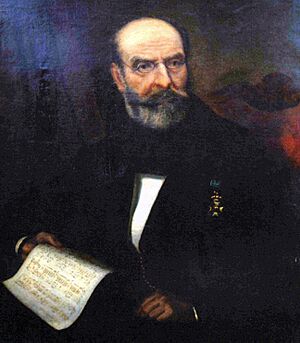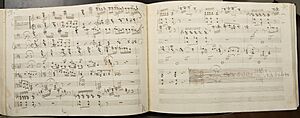Nikolaos Mantzaros facts for kids
Nikolaos Chalikiopoulos Mantzaros was a famous Greek-Italian composer. He was born in Corfu on October 26, 1795, and passed away on April 12, 1872. He is known as a key figure and founder of the musical style called the Ionian School.
Contents
Early Life and Music Training
Nikolaos Mantzaros came from a wealthy and important family in Corfu. Because of his background, he didn't see himself as a "professional composer." Instead, he taught music to young people in Corfu for free. His father was Iakovos Chalikiopoulos Mantzaros, and his mother was Regina Turini.
Mantzaros learned music in his hometown. His teachers included Stefano and Gerolamo Pojago, who taught him piano and violin. He also learned music theory from Stefano Moretti and composition from cavalliere Barbati.
First Compositions
In 1815, Mantzaros showed his first musical works. These included three concert arias and a short comic opera called Don Crepuscolo. He presented these at the San Giacomo theatre in Corfu.
Travels to Italy
From 1819 onwards, Mantzaros often traveled to Italy. He visited cities like Venice, Bologna, Milan, and Naples. During his travels, he met other important musicians, including the famous Neapolitan composer Niccolo Antonio Zingarelli.
Mantzaros's Musical Works
Mantzaros wrote many different kinds of music. He composed music for plays and songs in both Italian and Greek. He also wrote sacred music for churches. This included three masses for the Catholic Church and a complete mass for the Greek Orthodox Church. This Orthodox mass used traditional Greek singing styles.
He also wrote music for bands and instrumental pieces. He created 24 piano pieces called sinfonie, some of which could also be played by an orchestra. In 1827, Mantzaros composed the first concert aria in Greek, called the Aria Greca.
Mantzaros was also an important music theorist and teacher. He taught counterpoint, which is about combining different melodies. From 1841 until he died, he was the Artistic Director of the Philharmonic Society of Corfu.
The Greek National Anthem
Mantzaros's most famous work is the music he wrote for the poem Ýmnos eis tīn Eleutherían (Hymn to Liberty). The poem was written by Dionysios Solomos. Mantzaros added his music to the poem in 1828.
The first two parts of this song were chosen as the Royal Anthem of Greece in 1864. Then, on June 28, 1865, it officially became the Greek national anthem.
Even though he is best known for the national anthem, recent studies show that Mantzaros was a very important composer and music theorist. His work goes far beyond just this one famous piece.
Recordings of His Music
You can find recordings of Mantzaros's music, including:
- Mantzaros-Solomos: The Hymn to the Liberty (1991)
- Music of the Ionian School. N.Mantzaros, N.Lambelet, P.Carrer (1996)
- Nikolaos Halikiopoulos Mantzaros (1795-1872): Early Works for voice and orchestra (1815-1827) (2005)
- Don Crepuscolo performed by Christophoros Stamboglis, George Petrou and Armonia Atenea (2011)
- Partimenti for String Instruments performed by Ionian String Quartet (2011)
See also
- Antonios Liveralis
- Ionian School



